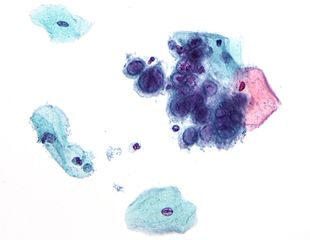 The virus that causes cold sores can be modified to also fight cancer.
The virus that causes cold sores can be modified to also fight cancer.
On Monday night, Professor Kevin Harrington spoke to a busy audience at the Albion pub for the Pint of Science festival, which celebrates the fantastic breadth and depth of modern scientific research.
Professor Harrington is one of our research team leaders here at The Institute of Cancer Research in London, and he was talking about using viruses to treat cancer – an innovative technique which is delivering amazing benefits to some cancer patients.
In an entertaining talk, Kevin explained scientists have known for nearly 100 years that viruses can lead to cancer, and as early as the 1880’s, a surgeon called William Coley experimented with bacteria and infectious agents to fight cancer.
Coley saw that some cancer patients with infections fared better after surgery than patients without infections, which he thought could be harnessed to form a new type of treatment.
This early foray into immunotherapy lead to the development of a cancer treatment called Coley’s Toxins, a mixture of bacteria which could boost the patient’s immune system to help fight their disease.
Coley’s treatment was used to fight cancer for almost 70 years, and while modern scientific evidence supporting its effectiveness is mixed, it shows it is possible to use the body’s own immune system to fight cancer.
So how do viruses fight cancer?
At the ICR, Kevin Harrington and his team are focusing on two viruses that have been engineered to seek out and destroy cancer cells and help recruit the patient’s own immune system to clean up the mess and target other tumour cells.
T-VEC is a genetically modified version of the HSV1 virus, better known as oral herpes. Interestingly, T-VEC was originally developed from a sample supplied by a post-doctoral researcher with a particularly nasty cold sore!
The T-VEC virus was modified by deleting two important parts of its DNA: deleting a region called ICP34.5 prevented the virus from being able to replicate in healthy cells, while deleting the region ICP47, which normally helps HSV1 hide from the immune system, makes the virus visible to our bodies again.
In addition, the human gene GM-CSF was added to the virus to enable it to make a protein that potently activates the immune system.
The result is a virus that selectively replicates in cancer cells, bursting and killing them, which can then be mopped up by our immune system – ingenious, and devastatingly effective.
The ICR and its partner hospital, the Royal Marsden NHS Foundation Trust, helped develop T-VEC through phase I and II trials, and the treatment has recently gone through a phase III trial in melanoma patients. Some patients on the trials have been disease free for six years, which could mean their cancer has been cured.
T-VEC must be injected directly into a patient’s tumour to be effective, but another virus being investigated by Kevin’s team could be delivered via the bloodstream like any normal drug. Reolysin is a type of reovirus which exploits a viral mechanism called ‘hitch-hiking’ to pass from white blood cells into tumour cells.
Normally, our cells are protected from reovirus infection by a protein called PKR, which prevents the virus from replicating. But in cancer cells, a signalling protein called Ras blocks PKR activity, allowing the virus to invade tumour cells while healthy cells are protected.
Abnormal Ras activity is common in cancer, so Reolysin could be used to treat a wide range of cancer types.
Preliminary results for both viruses as cancer treatments are promising, but the researchers are also finding the effects of treatment can last long after the virus has disappeared out of the patient’s system.
In some patients, after treatment, the immune system begins to recognise the cancer cells as being a threat, even when not infected by virus, and it becomes even more vigilant to identify and keep tumours at bay.
These are just two examples of how viruses can be used to treat cancer, and combining oncolytic viruses with conventional treatments could offer even further benefits, so this novel therapy could be benefiting patients very soon.
comments powered by